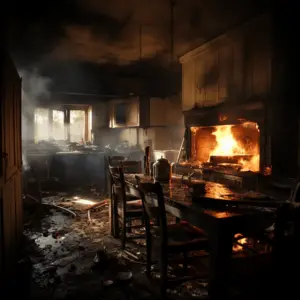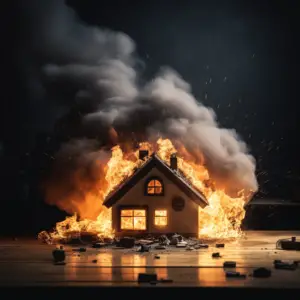Fire safety is key to keeping our homes and loved ones safe. Everyone should know how to protect themselves and their properties from fires. Here, we’ll look at strategies and precautions to prevent a destructive blaze.
Install smoke detectors on each level of the house. Test them regularly to make sure they’re working well. Have fire extinguishers in key areas, like the kitchen and garage, to put out small fires quickly.
Understand possible fire hazards in the home. Be mindful of electrical appliances and cords. Don’t overload power outlets. Practice safe cooking habits – never leave stovetops unattended and keep flammables away from heat sources.
Prevent fires from happening. And, have an evacuation plan if there’s an emergency. Designate escape routes with multiple exits from each room. Have meeting points outside the house. Practice evacuation drills so everyone knows what to do in high-stress situations.
Table of Contents
Understanding the importance of fire safety

Fire safety is key to protecting your home and loved ones from fires. It’s essential to understand its importance in avoiding harm to lives, property, and memories. Be proactive in taking preventative measures and staying informed about fire hazards.
Understand potential sources of ignition around your home. These include faulty wiring, improperly stored flammable materials, open flames, and smoking around combustible substances. Identify these risks to minimize the likelihood of a fire.
Smoke alarms are vital for fire safety. They act as early warning systems, alerting you to smoke or heat. Test their functionality regularly for reliable protection in case of an emergency. Fire extinguishers placed in accessible areas can help contain small fires.
Practicing fire safety isn’t just about preventative measures. Create an evacuation plan in case of a fire. Regular drills will help all household members know the escape routes and meeting points. This preparedness saves time and reduces panic.
Assessing the potential fire hazards in your home
Secure your home from fire hazards!
- Check electrical items for loose or frayed wires, overloaded power outlets, and faulty equipment. Don’t rely on extension cords.
- Keep flammable items away from stoves and ovens. Clean grease buildup in kitchen appliances regularly.
- Inspect heating systems such as furnaces, fireplaces, and space heaters for malfunctions or blockages.
- Cigarettes must be disposed of properly. No smoking indoors. Place sturdy ashtrays on non-flammable surfaces and make sure all smoking materials are extinguished.
- Store flammable liquids in a well-ventilated area away from open flames.
- Install smoke detectors on every floor, especially near bedrooms.
- Plan an escape route for fire emergencies.
Reminder: Prevention is key!
Incredibly, cooking equipment is the leading cause of house fires in the USA, according to the NFPA.
Installing fire alarms and smoke detectors
Choose the right spot! It’s vital to pick ideal sites for fire alarms and smoke detectors. Put them in each floor of your house – even the attic and basement. Put them close to bedrooms and common rooms, like living rooms or hallways. That way they will work best.
Read and follow maker’s directions when installing fire alarms and smoke detectors. Most devices are simple to set up and you only need simple tools such as drills or screwdrivers. Don’t forget to give them regular tests to make sure they are all working fine.
Maintenance is also important to make sure the alarms and detectors do their job. Clear them of dust or other bits that might have accumulated. Change the batteries once a year or when the maker recommends. Keep up with new alarm system tech to guarantee you have dependable equipment.
Also, linked fire alarms are highly recommended. They give an extra layer of safety by making all alarms go off at the same time when one detects smoke or fire.
Creating an escape plan
- Assess your home: Identify all exits in each room. This includes windows, doors, and alternative routes like balcony access or a back door.
- Choose a meeting point: Pick a safe location outside the house for everyone to gather after escaping. This could be a neighbor’s house, a tree, or another recognizable landmark.
- Assign responsibilities: Each family member should have a specific role during an evacuation. For example, one person may grab documents, another secure pets, and another ensure everyone exited the building.
- Practice regularly: Have regular drills. Set off the smoke alarms and time how long it takes to reach the meeting point.
- Stay informed: Keep up-to-date with fire safety information from local authorities or fire departments. Learn about common causes of fires and take precautions.
- Pro Tip: Make your escape plan visible and accessible. Put it on the fridge or near the front door, so everyone can refer to it during an emergency. Safety is always the top priority!
Fire extinguishers: types and usage
Fire extinguishers come in different types and are built for certain purposes. It’s essential to know the various types and how to use them to safeguard your home from fire danger. See the table below for comprehensive info on fire extinguisher types and their usage.
| Type of Fire Extinguisher | Suitable for… | Not Suitable for… |
|---|---|---|
| Water | Class A fires | Class B, C |
| Foam | Class A, B | Class C |
| CO2 | Class B, C | Class A, D |
| Dry Powder | Class A, B, C | N/A |
Moreover, each extinguisher has a certain class rating to display how effective it is against particular kinds of fires. For example, a 2A rated fire extinguisher is more powerful than a 1A rated one.
Pro Tip: Always check the pressure gauge of your fire extinguisher to make sure it’s ready for use in an emergency.
Safe practices in the kitchen
Kitchen fires can be a serious hazard if proper precautions are not taken. Here are some key fire safety steps to keep in mind:
- Keep flammable materials away from heat sources.
- Clean grease buildup on surfaces and fans to avoid ignition.
- Never leave cooking unattended; always stay in the kitchen.
- Don’t wear loose clothing when cooking near heat.
- Keep a fire extinguisher handy.
Small kitchen fires can quickly get out of control. Consider installing smoke alarms in the kitchen area. Additionally, maintain and use electrical appliances as per guidelines.
Fire safety is essential. Take the necessary steps today before it’s too late. Small steps make a big difference in protecting your home and loved ones.
Electrical safety tips
Electrical Safety Tips: When it comes to keeping your home safe from fire, electrical safety is essential. Here’s some handy advice to follow:
- Inspect electrical cords for signs of damage or wear. Replace them immediately if you spot fraying or exposed wires.
- Don’t overload outlets. Use power strips and extension cords wisely. Spread the load out and never plug multiple high-wattage appliances into the same outlet.
- Check that all light bulbs are the right wattage for the fixture. Using too-high wattages can cause overheating and fire hazards.
- Invest in surge protectors to protect your electronics from power surges. These devices help regulate voltage and protect against fires caused by electrical spikes.
- Install ground fault circuit interrupters (GFCIs) in wet areas, such as bathrooms and kitchens. GFCIs detect electrical current imbalances and quickly cut off power to prevent electric shocks or fires.
Plus, check your circuit breaker box regularly for signs of overheating or malfunctioning components. Also, educate yourself and family members about the right use of electricity and safety practices.
Let me share an example: A couple was at home, smelling something burning. They traced the stench to their basement. An old extension cord had overheated and sparked a fire. Luckily, they had smoke detectors which alerted them in time to put out the fire.
So, be proactive and knowledgeable about electrical safety. It can save lives and protect homes from fires. Stay attentive!
Proper storage and handling of flammable materials
Store flammables in designated areas! Ventilated spaces away from any ignition sources. Use proper containers – tightly sealed to prevent leakage/vapor release. Handle with care – gloves, goggles, protective clothing. No smoking/open flames in vicinity.
Inspect storage area for deterioration/damage. Leakages/faulty containers addressed swiftly.
Ventilation systems/windows open when handling flammables. Label containers/hazard warnings. Fire extinguishers nearby. Educate yourself how to operate them.
Adhere to these practices – minimize chances of fires. Stay vigilant – enforce safety measures to protect yourself/loved ones from devastating consequences.
Regular maintenance and inspections

Regular maintenance and inspections of your home can help you spot any potential fire hazards. Doing this can save you from a potentially catastrophic event!
Inspect wiring, outlets, and appliances for frayed cords, loose connections, or overheating. Clean out dryer vents to remove lint. Test smoke alarms each month and replace batteries yearly.
Keep hazardous materials away from heat sources. Store chemicals and gasoline in well-ventilated areas. Maintain your heating system annually. Make sure heating equipment has proper clearance.
Be sure to also inspect your electrical system regularly. Doing so can be the difference between averting a disaster and experiencing a devastating fire.
Conclusion
Fire safety in the home is a must! Smoke detectors, fire extinguishers, and electrical checks are all important preventive steps. Educating yourself and your family on the right fire safety procedures is a must too. Get a sprinkler system to have additional fire protection. Also, stay updated on the latest fire prevention tech and materials. Lastly, clear any dry leaves and debris outside. And remember, store flammable materials properly and dispose of them safely. Pro Tip: Don’t forget to install carbon monoxide detectors too!
Frequently Asked Questions
1. How often should I test my smoke alarms?
It is recommended to test your smoke alarms at least once a month. This ensures they are functioning properly and will alert you in case of a fire.
2. What should I do if a fire starts in my home?
If a fire starts in your home, the first step is to evacuate immediately. Stay low and crawl if there is smoke. Call emergency services and do not re-enter the house until it is safe to do so.
3. How can I prevent fires in my home?
To prevent fires, ensure you have working smoke alarms, avoid smoking indoors, never leave cooking unattended, and keep flammable materials away from heat sources. Also, remember to unplug electrical appliances that are not in use.
4. Should I have a fire escape plan for my family?
Yes, it is crucial to have a fire escape plan for your family. Create a plan with clear escape routes and designate a meeting point outside. Practice the plan regularly, especially with children, to ensure everyone knows what to do in case of a fire.
5. Can I use a fire extinguisher to put out a small fire?
If you encounter a small fire that you think you can handle, you may attempt to use a fire extinguisher. Remember the acronym PASS – Pull the pin, Aim at the base of the fire, Squeeze the handle, and Sweep from side to side. However, always prioritize your safety, and if the fire becomes uncontrollable, leave the area immediately.
6. Are there any precautions I should take with heating equipment?
Yes, when using heating equipment, ensure proper ventilation, keep flammable materials away from them, and never leave them unattended. If using space heaters, maintain a safe distance from combustible objects and always turn them off before leaving the room or going to bed.